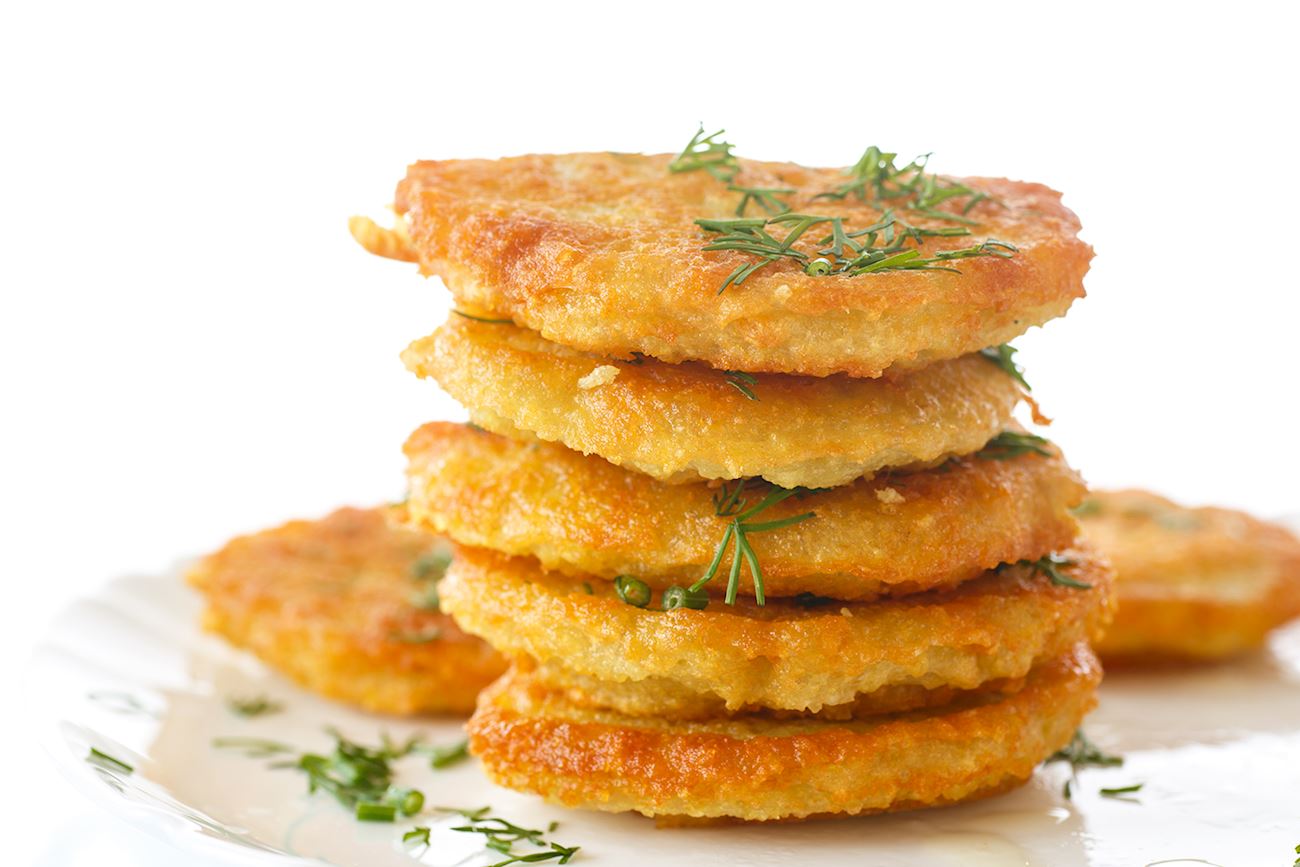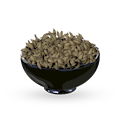MAIN INGREDIENTS
Garantita is a popular Algerian street food item that is consumed as a snack and prepared as a kind of cake or tart. The dough is made with a combination of chickpea flour, oil, spices, and water. It is then covered with a beaten egg and baked in the oven until it develops a golden-brown color on top.
Garantita is typically served hot, dressed with harissa and cumin. It is believed that the name of this street snack is derived from the Spanish caliantetorta.
MAIN INGREDIENTS
Maakouda are traditional potato fritters that are popular throughout the Maghreb, especially in Morocco, Algeria, and Tunisia. The fritters are usually prepared plain, but they can also be stuffed with meat, tuna, or cheese, although not that often.
They're made with potatoes, parsley, garlic, flour, salt, and pepper. The potatoes are boiled, mashed, and mixed with other ingredients into small disks which are then deep-fried in hot oil until golden brown. Maakouda is traditionally served as an appetizer, a side dish, or an ingredient in a long sandwich roll that's usually sold as street food and served with harissa, coriander, and lemon juice.
MAIN INGREDIENTS
Mahjouba is a traditional flatbread that is one of the most popular street food items in the country. These thick and flaky crepe-like flatbreads are made with semolina, then filled with a combination of tomatoes and caramelized onions. Mahjouba is often paired with harissa sauce on the side, but the condiment is completely optional.
Sfenj are popular Moroccan and Algerian doughnut-like fritters made from sticky unleavened batter, similar to Libyan sfinz and Tunisian bambalouni. The dough is traditionally shaped into rings and deep-fried until it develops a golden, crispy exterior.
The interior should be fluffy, tender, and chewy. These fritters are usually served hot when sold by street vendors, and they can be consumed plain or dusted with icing sugar.
Tunisian brik is a popular dish that incorporates flaky dough filled with a variety of savory ingredients. Traditionally, malsouqa dough is used to create brik, but the more available phyllo pastry is commonly used as a replacement. Brik is usually made with layers of laminated pastry, to achieve a crunchy, layered texture.
The pockets are filled with stuffing, skilfully folded, then shortly fried in deep oil or baked in an oven. The most common filling is tuna-based, enriched with traditional North African spices such as cilantro, chilis, pepper, or coriander seeds.
A raw egg is often placed on top of the tuna filling, the pastry is carefully folded, and the egg partially cooks inside the flaky pastry.
Kafteji is a traditional dish made with fried vegetables. Typical veggies used in the dish include eggplants, bell peppers, potatoes, tomatoes, zucchinis, and pumpkins. The vegetables are fried, chopped, then combined with (often fried) eggs and seasonings.
The dish is often sprinkled with parsley or coriander, and it's then served as a side to poultry or fish, although it can be eaten as it is. Kafteji is also a popular Tunisian street food, often served in a baguette.
MAIN INGREDIENTS
Moroccan stuffed sardines or sardine mzeouej (married sardines) is a traditional fish dish. The dish is usually made by butterflying sardine fillets and stuffing them with chermoula, a concoction made with a combination of garlic, paprika, hot peppers, cumin, salt, olive oil, parsley, lemon juice, and coriander.
The sardines are rubbed with chermoula, coated with flour, and fried in hot oil on both sides. Once done, the fried stuffed sardines are served warm or at room temperature, often accompanied by lemon wedges, harissa, or fresh salads based on tomatoes, cucumbers, and onions.
MAIN INGREDIENTS
Kalinté is a traditional street bread originating from Tangier. It's usually made with a combination of chickpea flour, eggs, olive oil, salt, lukewarm water, and ground cumin or harissa sauce. Once prepared, the batter should be smooth and chilled for a while before it's baked in a brick oven, usually in a deep-dish pan.
The top of kalinté is brushed with oil and it should be golden brown and glazed once it's baked. Kalinté is eaten by the slice, often as a small rectangle, and it's sprinkled with cumin or harissa before serving. The name of this flan-like dish is the Tangier slang word for heat.
TasteAtlas food rankings are based on the ratings of the TasteAtlas audience, with a series of mechanisms that recognize real users and that ignore bot, nationalist or local patriotic ratings, and give additional value to the ratings of users that the system recognizes as knowledgeable. For the “Top 8 Maghrebi Street Foods” list until March 21, 2025, 1,485 ratings were recorded, of which 266 were recognized by the system as legitimate. TasteAtlas Rankings should not be seen as the final global conclusion about food. Their purpose is to promote excellent local foods, instill pride in traditional dishes, and arouse curiosity about dishes you haven’t tried.








